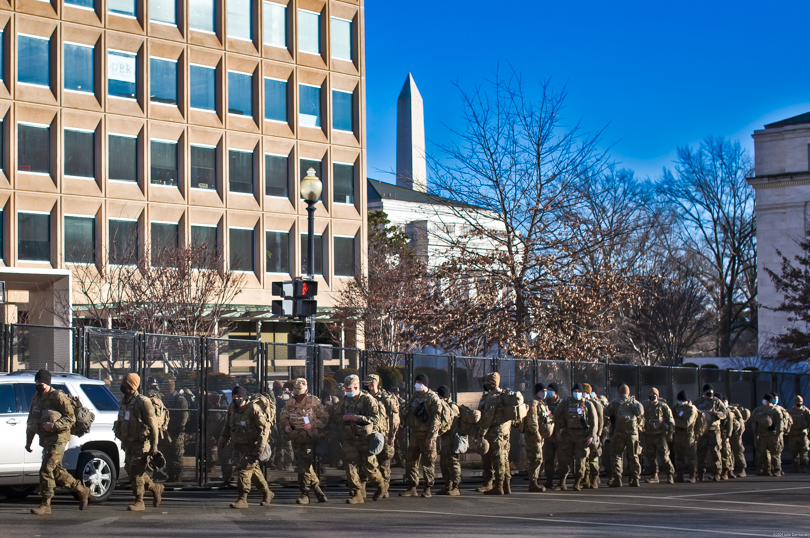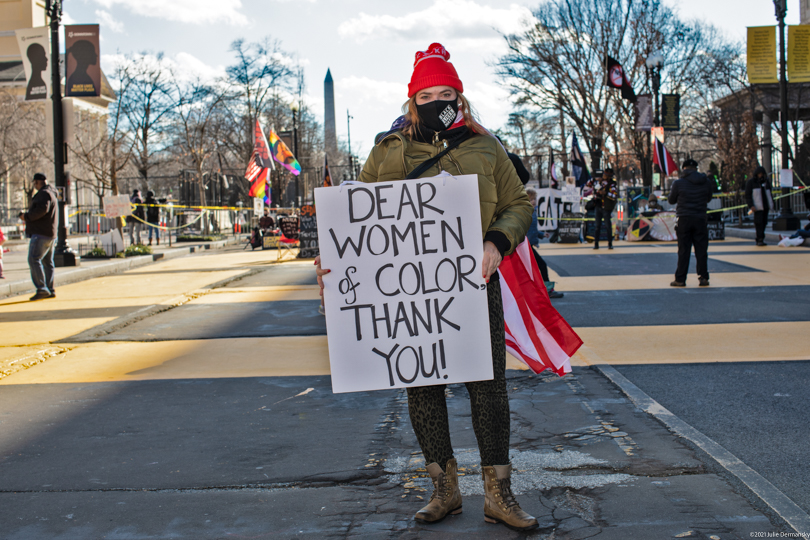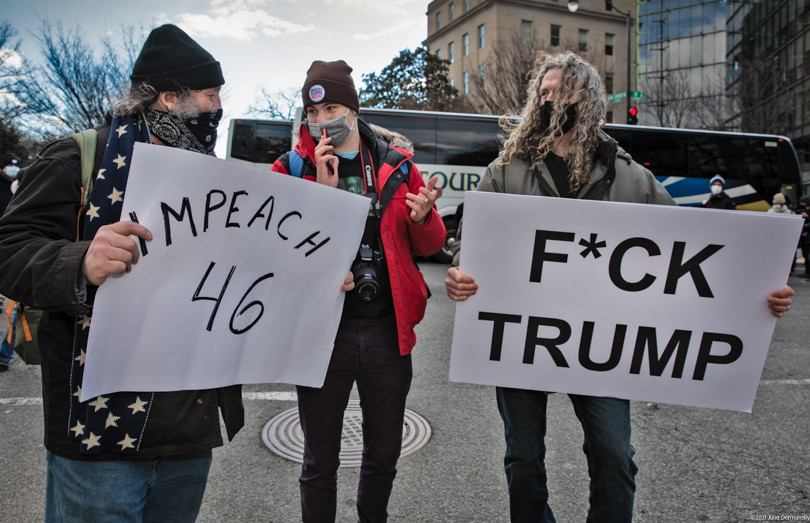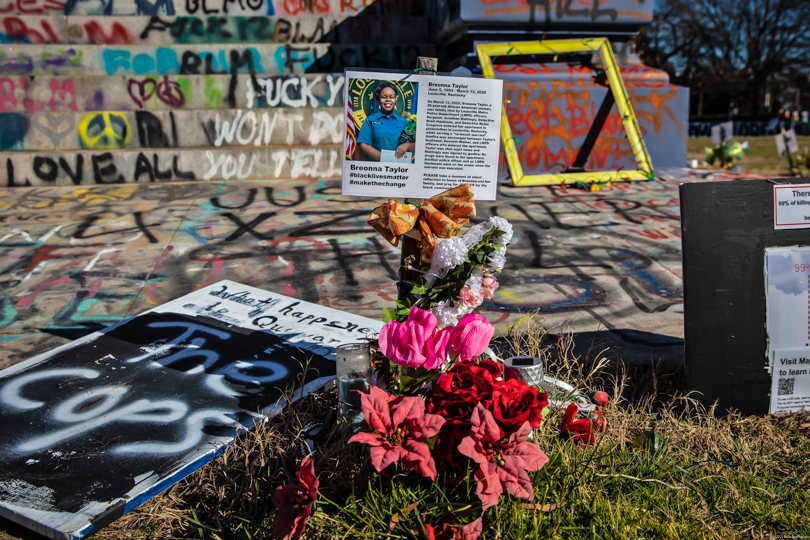A few hours before President Joe Biden was inaugurated, I talked to a supporter of President Donald Trump in Washington D.C. who was on her way to celebrate Trump’s inauguration at The Ellipse, a federal park near the White House. She didn’t want to give her name but once I identified myself as a reporter she wanted to be sure that I would spread the word that Trump had actually won the election.
I asked her if she knew that Trump had already left the White House and had reached his home in Florida. “It doesn’t matter where he is,” she said, “he can be sworn in from anywhere.”
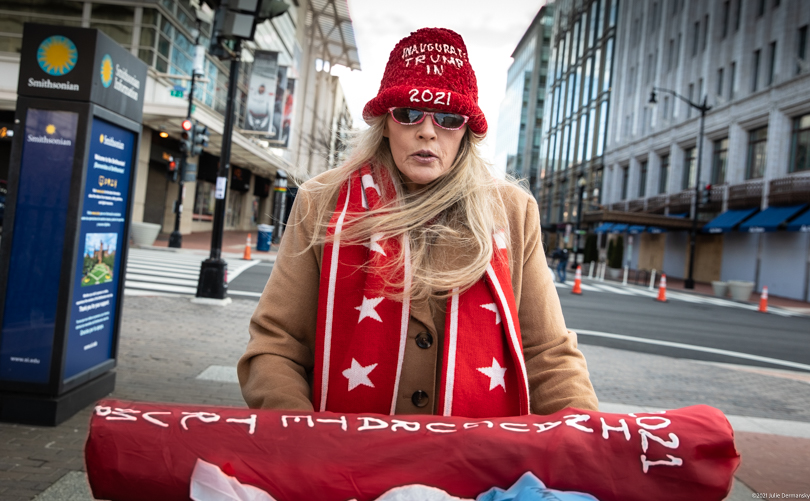 Woman in Washington D.C. who said she was headed to a Trump inauguration, which did not take place, on January 20, 2021. Credit: Julie Dermansky © 2021.
Woman in Washington D.C. who said she was headed to a Trump inauguration, which did not take place, on January 20, 2021. Credit: Julie Dermansky © 2021.
I also let her know that she wouldn’t be able to get anywhere near The Ellipse — the place where two weeks earlier, Trump supporters launched their failed insurrection — because all of the streets leading toward that area were shut down. I offered her information I had about where there were designated protest areas in the other direction.
She discounted what I said and assured me that she was sure she could get where she was going. Her response to my warning felt familiar — it was similar to the responses many Trump supporters have given me when I offer them information based on facts.
She also wasn’t alone in chasing false claims about the inauguration. The Washington Post reported on Thursday: “QAnon promoters have in the past day held up an incoherent set of new theories to explain away Trump’s anticlimactic exit from Washington; that the military is in control of the country, not Biden; that Biden and Trump have switched faces; that Biden’s inauguration was illegitimate, and that the real one (for Trump) would take place in March; or that Biden has been in on the QAnon plan all along.”
Denial of the election results has joined the ranks of pandemic and climate denial. Basic facts — like Biden won the election by over seven million votes, wearing a mask will help stop the spread of the pandemic, and cutting carbon emission will slow climate change — are discounted with outlandish falsehoods. “The election was stolen” has joined the ranks of alternative facts.
From the first briefing, where Trump’s first press secretary Sean Spicer insisted that Trump’s inaugural crowd size was the largest ever to reporters who covered Obama’s inauguration and knew first-hand that he was lying, it was clear that for reporters getting to the truth of everything was going to take more work than usual. Kellyanne Conway, Trump’s former campaign manager and counsellor, made that abundantly clear by backing Spicer up, insisting “alternative facts” served just as well as the real facts, which in part could explain the delusions many Trump supporters hold to be true.
In the final count of the popular vote, more than 74.2 million Americans cast their ballots for Donald Trump in the 2020 election — a sizeable turnout, but also a very clear minority, their numbers distinctly dwarfed by the more than 81.2 million Americans who voted for Joe Biden (and by a roughly equal number of eligible voters who cast no ballot at all).
I was in Washington, D.C. to document the city in the days leading up to Biden’s inauguration for DeSmog, as I had done fours year ago when I documented Trump’s inauguration and the Women’s march that followed.
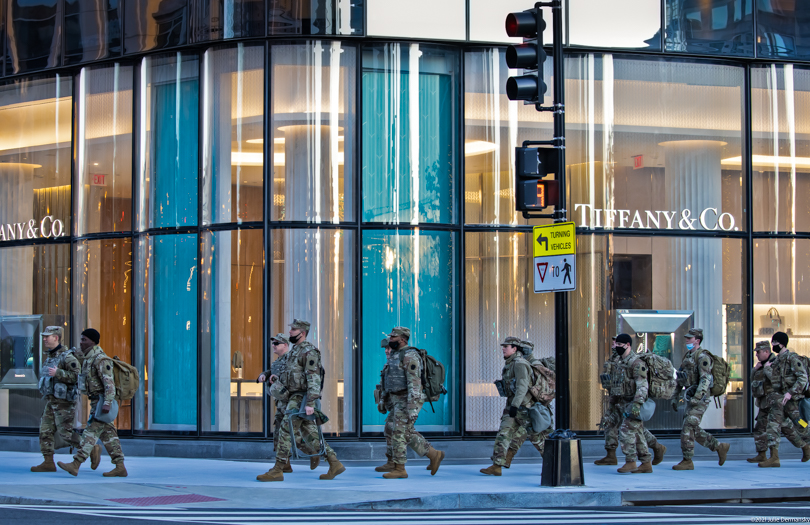 Troops in Washington DC on January 20, 2021. Credit: Julie Dermansky © 2021.
Troops in Washington DC on January 20, 2021. Credit: Julie Dermansky © 2021.
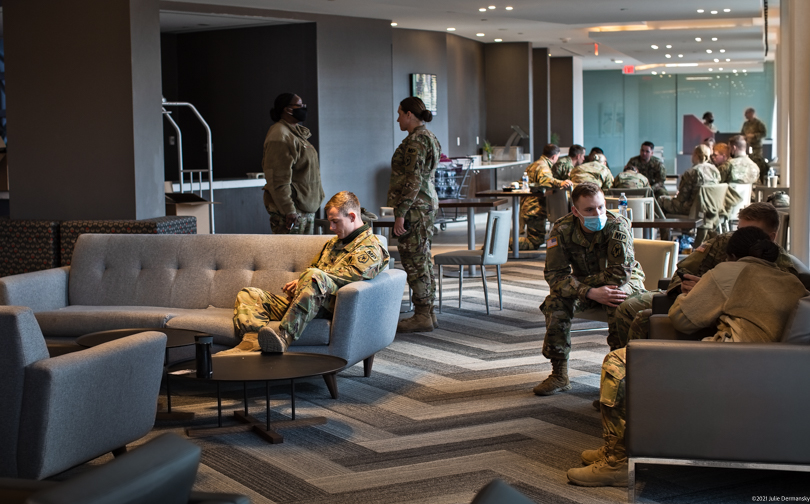 Military in the Cambria Hotel in Washington DC. Credit: Julie Dermansky © 2021.
Military in the Cambria Hotel in Washington DC. Credit: Julie Dermansky © 2021.
The two experiences bookmarking Trump’s term were drastically different affairs. During Trump’s inauguration, protesters skirmished with Trump supporters and law enforcement on D.C.’s streets. Hundreds were detained, including journalists, medics, and legal observers, and 234 people were arrested (one person ultimately pled guilty on felony charges, 20 to misdemeanors, and the remainder had their charges dropped or were acquitted, in part after an Assistant U.S. attorney was caught hiding exonerating evidence). The day after those protests, over half a million people arrived in the streets of D.C. — joining over three million around the world — for the Women’s March in opposition to Trump.
For Biden’s inauguration the streets were nearly empty — cleared by a military and police presence in the wake of an attempted insurrection by Trump supporters that left five dead. I found a couple dozen anti-abortion protesters who said they were not fans of either Trump or Biden, less than a dozen Trump supporters and about a dozen Biden supporters on the streets near the back of the U.S. capitol building.
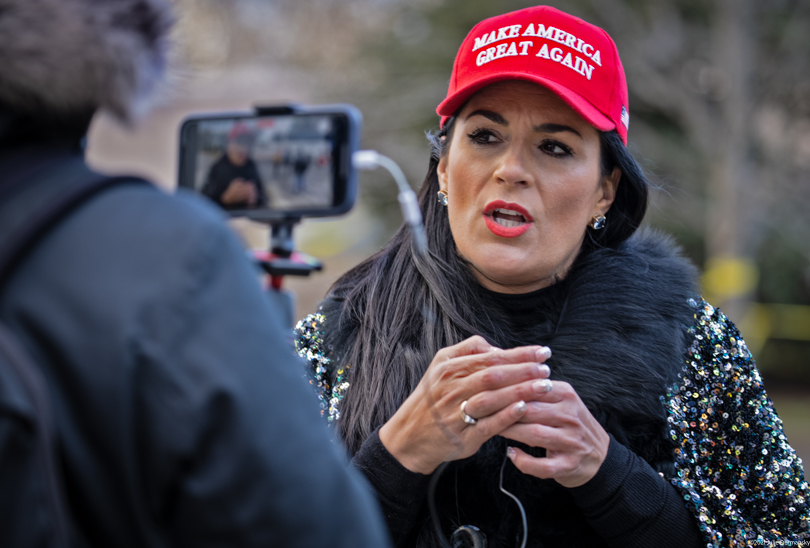 Trump supporter on January 20, 2021 telling a reporter that Trump won and that although Biden was inaugurated Trump would be back in power. Credit: Julie Dermansky © 2021.
Trump supporter on January 20, 2021 telling a reporter that Trump won and that although Biden was inaugurated Trump would be back in power. Credit: Julie Dermansky © 2021.
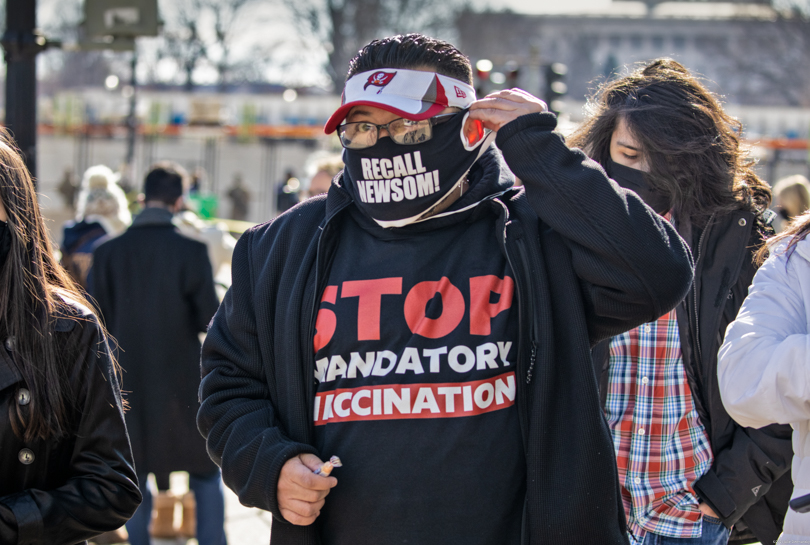 A protester wears a tee-shirt opposing vaccination against infectious diseases. Credit: Julie Dermansky © 2021.
A protester wears a tee-shirt opposing vaccination against infectious diseases. Credit: Julie Dermansky © 2021.
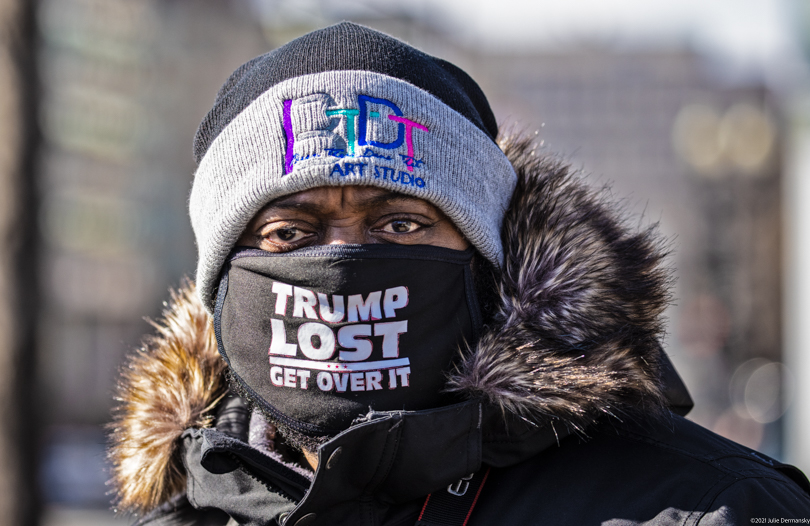 Biden supporter celebrating inauguration day in Washington D.C. Credit: Julie Dermansky © 2021.
Biden supporter celebrating inauguration day in Washington D.C. Credit: Julie Dermansky © 2021.
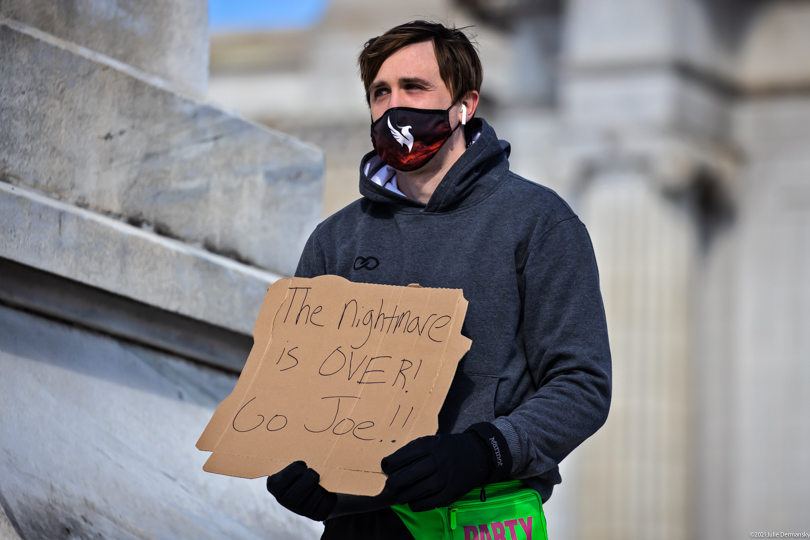 Biden supporter with a sign indicating his relief that the Trump years are over. Credit: Julie Dermansky © 2021.
Biden supporter with a sign indicating his relief that the Trump years are over. Credit: Julie Dermansky © 2021.
When I arrived in D.C. the night of the January 16, I encountered a roadblock almost two miles out from the National Mall. I was stopped and asked for ID when I took photos of a checkpoint manned by the military.
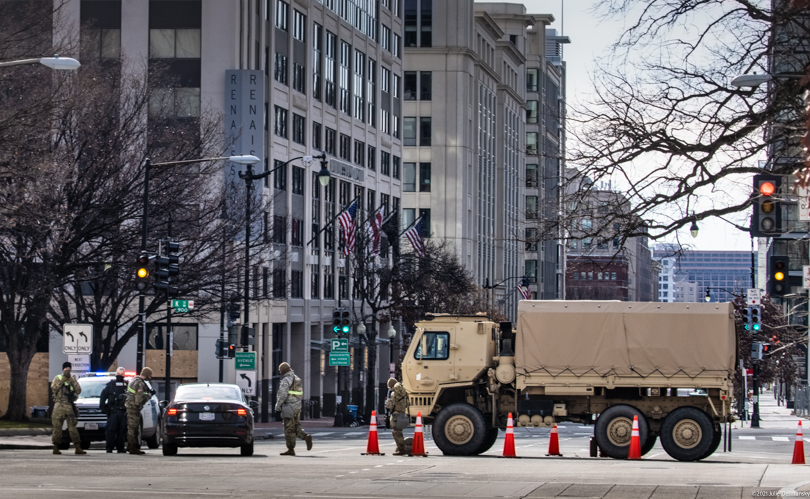 Roadblock on K and 9th Street in Washington D.C. in the lead up to Inauguration Day. Credit: Julie Dermansky © 2021.
Roadblock on K and 9th Street in Washington D.C. in the lead up to Inauguration Day. Credit: Julie Dermansky © 2021.
I was able to proceed as far as Pennsylvania Avenue — the road that stretches from the Capitol to the White House — that night after going through a checkpoint manned by about a dozen armed police, Secret Service and military personnel. I passed through a metal detector that my coat zipper set off, leading to an officer using a wand to pass over my body, front and back, after which I had to show a Secret Service officer that both of my cameras operated.
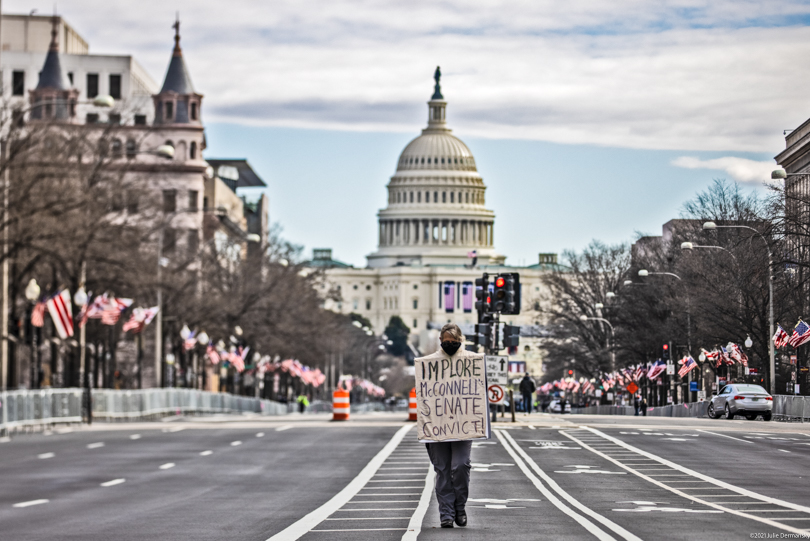 Anti-Trump protester, who resides on Pennsylvania Ave. in Washington D.C. on January 17. Credit: Julie Dermansky © 2021.
Anti-Trump protester, who resides on Pennsylvania Ave. in Washington D.C. on January 17. Credit: Julie Dermansky © 2021.
The next day on Pennsylvania Ave., I met a lone an anti-Trump protester, who also declined to give her name, walking up and down the near empty street. She lives on Pennsylvania Ave, she explained, so she was able to be inside the secured zone. “The police and military don’t want me here,” she told me. “But I protested against Trump when he was inaugurated and now I feel it is important to protest again to make sure his supporters are held accountable.”
By January 18, I could no longer get to Pennsylvania Ave. The area that media without passes were permitted to enter for the inauguration had been pushed back. There were a growing number of metal fences and dump trucks blocking intersections too. For the most part, within a mile and a half of the mall the streets of Washington D.C. were completely deserted, except for groups of troops and police marching by. On January 20, even more streets were blocked off.
That blocked off area in D.C. was referred to as the “Green Zone,” a term lifted from the heavily fortified area in Baghdad when it was occupied by U.S. troops. The Green Zone in Iraq was the most heavily fortified area in Baghdad, during a war that was started by the United States — also under a false premise.
Being on D.C.’s broad, emptied streets inside a restricted zone reminded me strongly of being in Iraq. I reported there from the end of 2008 through the start of May 2009.
Using the term Green Zone to describe the area where traffic flow restrictions were set up in the U.S. Capitol felt ominous. Though these restrictions were put in place following a failed insurrection attempt by Trump supporters, many linked to white-supremacist miltia groups, using a term lifted from an arguably illegal war to describe parts of an American city didn’t sit well with me or other residents I spoke to that lived within the restricted area.
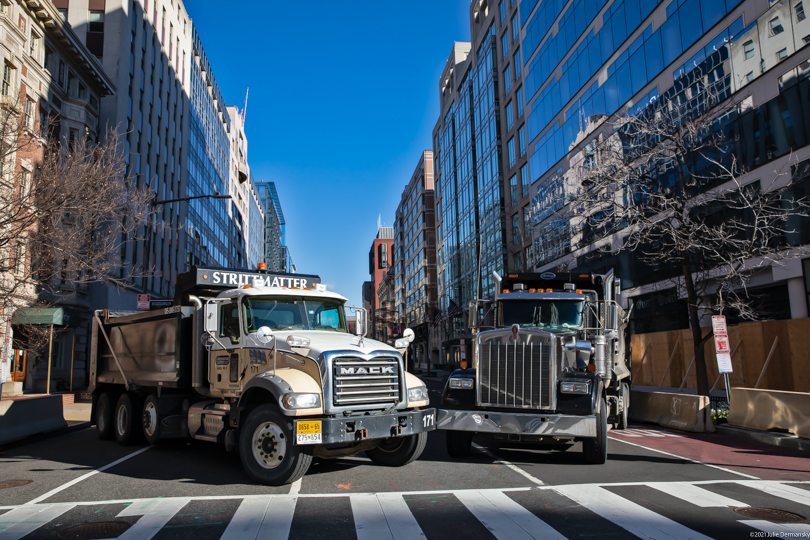 Trucks used as a road block in Washington D.C.’s “Green Zone’”ahead of inauguration. Credit: Julie Dermansky © 2021.
Trucks used as a road block in Washington D.C.’s “Green Zone’”ahead of inauguration. Credit: Julie Dermansky © 2021.
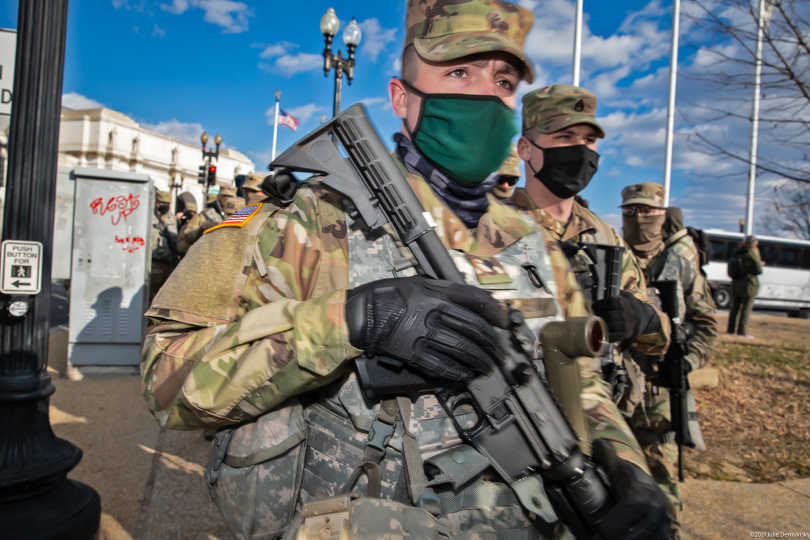 Military gathered near the back of the US Capitol on Jan 20 before departing on busses after the inauguration. Credit: Julie Dermansky © 2021.
Military gathered near the back of the US Capitol on Jan 20 before departing on busses after the inauguration. Credit: Julie Dermansky © 2021.
After a growing number of protests during the Trump administration over racial inequity and organized by Black Lives Matter activists whose work helped Democrats win the Senate and elect Biden, this militarization of an American city was chilling. Amid rising calls to defund police — which grew following the killings of George Floyd, Breonna Taylor, and a host of other people of color for which police remained unaccountable — it didn’t look like any expense was spared on police and military forces in D.C. where an unprecedented level of security forces were assembled to ensure a smooth transition of power after the failed insurrection on January 6.
The security bill for any inauguration — despite any celebrations being greatly scaled back due to the pandemic — will likely be record breaking.
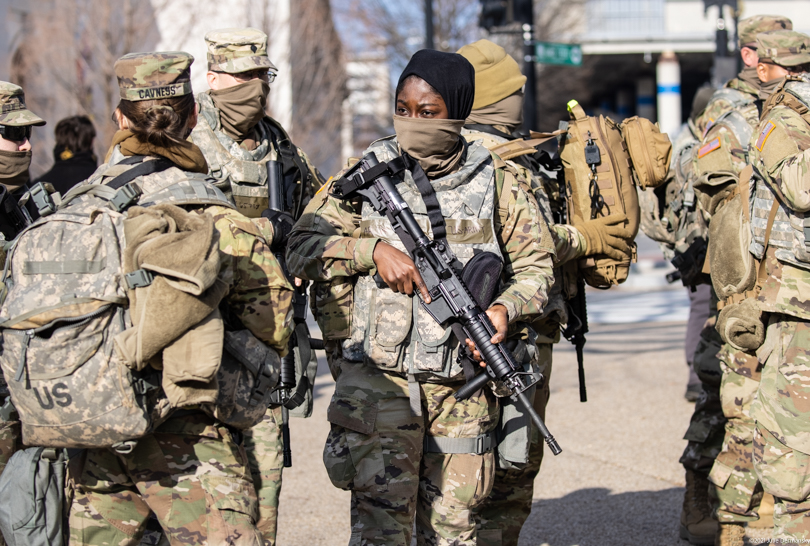 Members of the military carrying assault rifles in Washington D.C. Credit: Julie Dermansky © 2021.
Members of the military carrying assault rifles in Washington D.C. Credit: Julie Dermansky © 2021.
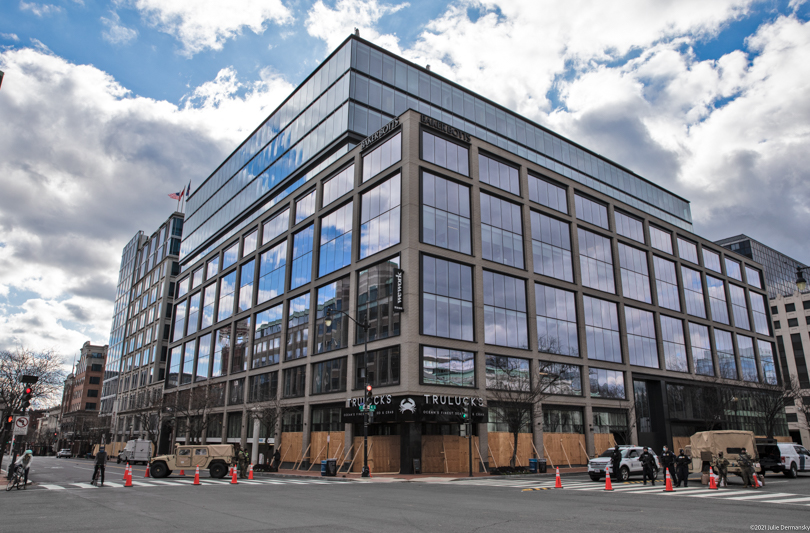 Checkpoint in Washington D.C.’s “Green Zone”. Credit: Julie Dermansky © 2021.
Checkpoint in Washington D.C.’s “Green Zone”. Credit: Julie Dermansky © 2021.
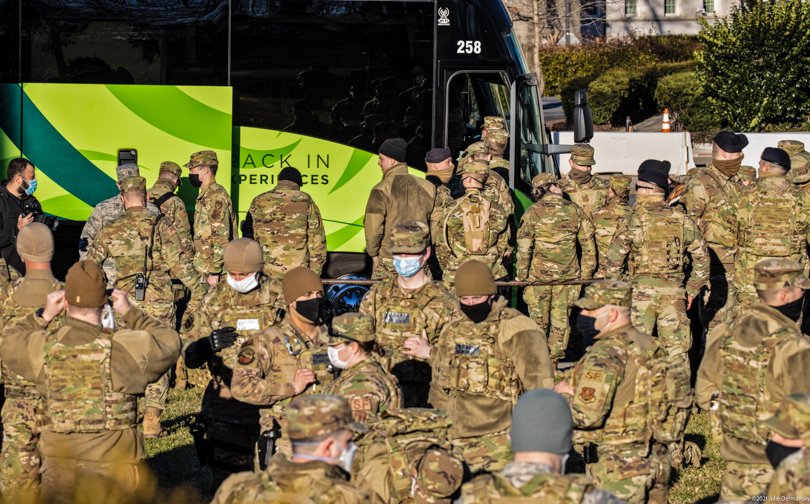 Troops in Washington D.C. on January 18, 2021. Credit: Julie Dermansky © 2021.
Troops in Washington D.C. on January 18, 2021. Credit: Julie Dermansky © 2021.
On January 18, as I exited one checkpoint, I found an encampment of D.C. residents experiencing homelessness living in tents and was reminded of the social issues facing the district and many other parts of America.
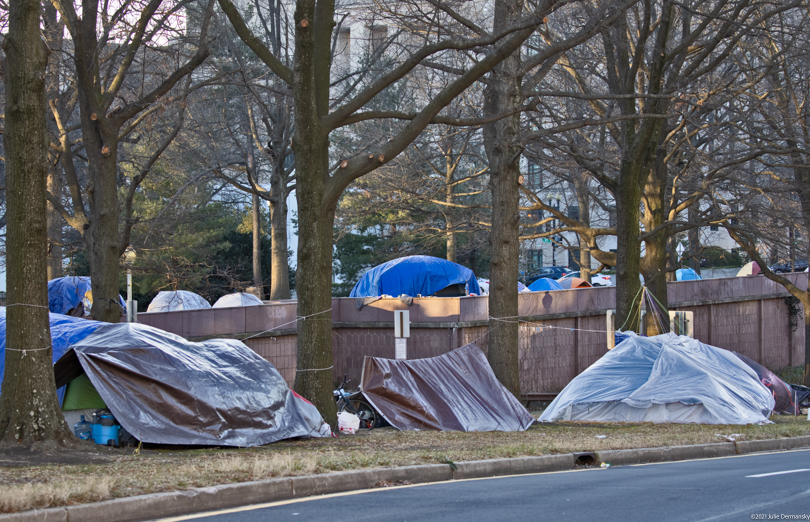 Tent encampment in Washington D.C. in January, 2021. Credit: Julie Dermansky © 2021.
Tent encampment in Washington D.C. in January, 2021. Credit: Julie Dermansky © 2021.
I was reminded of Washington D.C.’s other crumbling infrastructure too. At the corner of 3rd and E Street, I smelled the unmistakable oder of natural gas.
In 2014, researchers from Duke University documented thousands of leaking gas pipes in the nation’s capital, finding roughly 6,000 leaks as they drove 1,500 miles of D.C. streets, roughly four measurable gas leaks every mile. Four years later, scientists gathered methane leak data from six major U.S. cities including Washington D.C. and found that methane levels remained shockingly high in D.C. and other cities, double federal estimates.
Biden’s first acts impacting the environment, including revoking the permit for the Keystone KL pipeline and rejoining the Paris climate accord, were instantly hailed by environmentalists as big victories and criticized by conservatives.
“By rejoining the Paris Climate Agreement, President Biden indicates he’s more interested in the views of the citizens of Paris than in the jobs of the citizens of Pittsburgh,” Sen. Ted Cruz (R-TX), who spoke to the Trump insurrectionists on January 6, wrote. “This agreement will do little to affect the climate and will harm the livelihoods of Americans.”
“Nice tweet Sen. Cruz! Quick question: do you also believe the Geneva Convention was about the views of the citizens of Geneva?” Rep. Alexandra Ocasio-Cortez (D-NY) replied.
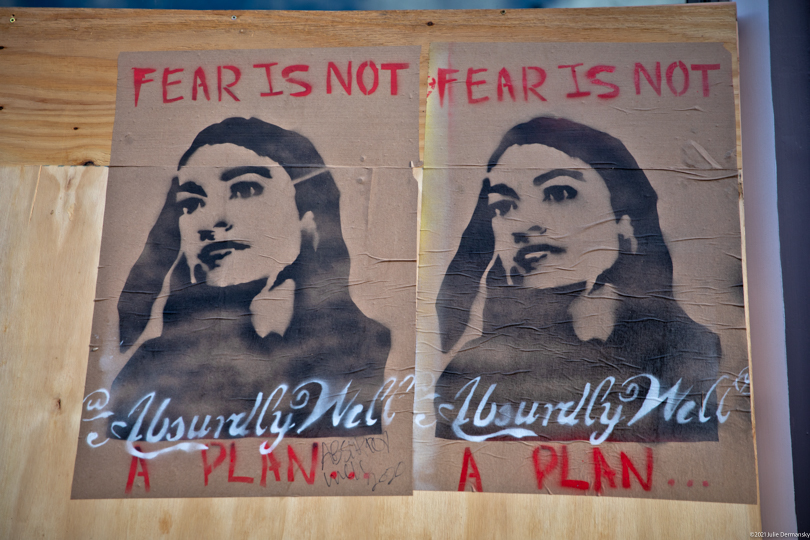 Portrait of Alexandra Ocasio-Cortez wheatpasted in Washington D.C. Credit: Julie Dermansky © 2021.
Portrait of Alexandra Ocasio-Cortez wheatpasted in Washington D.C. Credit: Julie Dermansky © 2021.
To be sure, Trump was not the first politician to be at odds with the media — but his labeling of all news he doesn’t agree with as ‘Fake News’, has done society a disservice by enabling false narratives that he professes to take hold in the minds of his followers. That, coupled with him fueling a hatred for members of the media, has made some journalists’ jobs more dangerous.
That reality was apparent on North Capitol Street, where a building that houses many media bureaus was not only boarded up, but logos of the media companies were covered too.
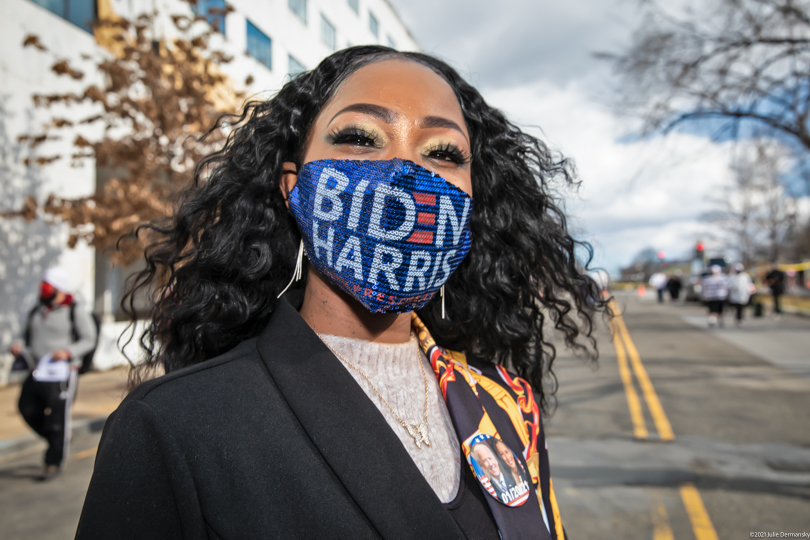 A Biden supporter in DC on Jan. 20, 2021. Credit: Julie Dermansky © 2021.
A Biden supporter in DC on Jan. 20, 2021. Credit: Julie Dermansky © 2021.
Back in my hotel room after the inauguration, it felt like something of a relief to watch Jen Psaki, Biden’s press secretary state at her first press briefing that she would be dealing in truth.
On my way back to Louisiana, I stopped to photograph one of the remaining confederate statues in Richmond, Virginia, which has become a shrine to people of color whose killers weren’t brought to justice. It was a stark reminder that Biden’s administration is going to have its hands full confronting America’s deep-rooted systemic racism, a pandemic Trump let spread almost unchecked, and policies that steered efforts to curb climate change in the wrong direction.
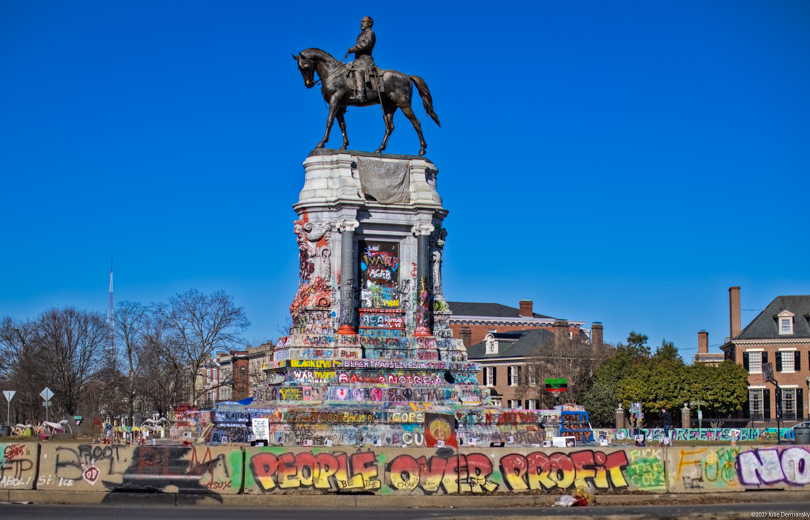 The Robert E. Lee monument in Richmond, Virginia, in January 2021. Credit: Julie Dermansky © 2021.
The Robert E. Lee monument in Richmond, Virginia, in January 2021. Credit: Julie Dermansky © 2021.
Reporting Contributed by: Sharon Kelly
Lead Photo: Millitary in Washington D.C. before Biden’s innuguarion on Jan 18. Credit: Julie Dermansky © 2021.Subscribe to our newsletter
Stay up to date with DeSmog news and alerts


